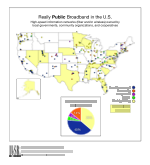ILSR issued a report in 2011 that updates this case study: Learning from Burlington Telecom: Some Lessons for Community Networks
In the modern world, broadband information networks are essential infrastructure, a combination of the past’s canals, telegraph wires, interstate highways, and airports. Unfortunately, other developed countries offer faster networks at cheaper prices to their businesses and citizens. Few disagree that the United States must solve this broadband problem.
This case study shows how one city did it. No private company was willing to build the high-speed information network Burlington, Vermont, needed on the timeline it wanted. Rather than hope and wait, they’re building it themselves. After their original plan collapsed, they persevered and developed a different model, using a tax-exempt municipal capital lease arrangement with an outside investor. The City will have direct ownership within 15 years; they already have complete control.
By mid 2008, all residents will be able to connect to a citywide fiber-optic network run by Burlington Telecom, a new city department. All government buildings and 1,800 other subscribers already use the network.
The publicly owned network is open access. As with roads, any service provider can use the network on the same terms, enabling true competition. It is universal; no neighborhoods were deemed unworthy for being connected. BT’s services come ala carte or in packages, from symmetrical high speed Internet access to an affordable triple play package (TV, voice, and Internet) for $45/month.
Perhaps most importantly, the community controls the network. It will be maintained and upgraded to fit the needs of Burlingtonians, not distant shareholders. The City projects that the net income from the network will provide 20 percent of its general fund after the debt is retired. Schools are already benefiting; they now pay nothing for their bandwidth. Businesses are paying less for faster connections. And BT is talking with nearby towns about partnering with them to solve their own broadband problems.
Building a fiber network is well within the competency of local governments. Hundreds of communities already own networks. Hundreds more are considering their options; each would do well to examine Burlington’s model.
2010 Update – New Developments
When this case study was written, Burlington Telecom appeared to be a model example of municipal ownership. By late 2009, a lot had changed. In late 2009, Burlington’s City Council learned that the Mayor’s Administration had been hiding Burlington Telecom’s financial problems. After Tim Nulty left BT in 2007, the Mayor’s Administration abruptly reversed Nulty’s philosophy of transparency. Because BT was technically a project of the Clerk-Treasurer office rather than a full-fledged city department, the City Council was limited in oversight capabilities. BT’s new management was less cooperative with both the City Council and citizen oversight boards.
In anticipation of a coming debt restructuring in 2008, the City began lending BT funds from its internal pool of funds (as it does with other city departments). However, the collapse of financial markets in 2008-2009 prevented the City from restructuring BT’s debt. The Mayor’s Administration decided to continue lending funds to BT so it could continue connecting new subscribers. This decision violated the City’s Certificate of Public Good, which limits the city in ways the private sector is not limited: the City cannot self-finance network expansion.
Burlington Telecom is now in a difficult position. The City has lent the network $17 million (which continues to accrue interest just as any other City Department’s debt would) and it owes some $30 million to Citi.
However, the network also continues to produce substantial benefits to the City. Since 2003, BT has provided city facilities with 100 Mbps and 1Gbps connections – speeds that were not even available in Burlington prior to the publicly owned network.
The market value of the closest comparable private services is over $2 million/year. However, the City has been paying BT $400,000/year for services, saving $1.5 million while also providing faster speeds than would otherwise be available. Further, BT pays a variety of fees and taxes (Payment in Lieu of Taxes, specifically) to the City that incumbents fail to pay. BT has attracted businesses and residents into town because it has offered faster speeds (especially upload) and better reliability than incumbent providers.
BT has produced many benefits for the community in the face of great odds, including competing against the largest Internet service provider in the country while being limited in how it can fund expansion. Nonetheless, oversight is an important responsibility; BT has proved that.
Read ongoing stories about these networks at ILSR’s site devoted to Community Broadband Networks. You can also subscribe to a once-per-week email with stories about community broadband networks.



